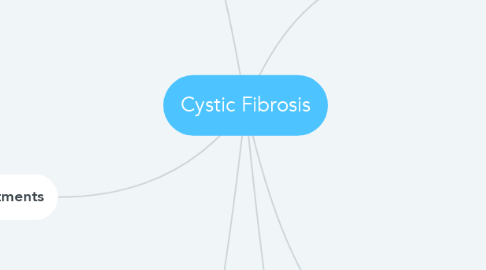
1. Common findings
1.1. very salty tasting skin
1.2. persistent cough, at times with phlegm
1.3. frequent lung infections
1.4. frequent coughing, dyspnea
1.5. poor growth or weight gain
1.6. frequent greasy, bulky stools
1.7. male infertility
1.8. complex disease, symptoms can vary widely
2. Treatments
2.1. Airway clearance
2.1.1. Chest physical therapy, chest clapping/percussion
2.1.2. breathing exercises
2.1.3. pulmonary rehab
2.2. Medications
2.2.1. Bronchodilators
2.2.2. Antiinflammatories
2.2.3. Antibiotics
2.2.4. the oral medication, Ivacaftor for those with mutation of G551D gene (5% have this mutation)
2.2.5. CFTR modulators
2.3. Lifestyle
2.3.1. avoid smoking
2.3.2. wash hands frequently to prevent infections
2.3.3. exercise
2.3.4. drinking plenty of fluids
2.4. Managing digestive problems
2.4.1. oral pancreatic enzymes to assist digestion of fats & proteins, and to help absorb more vitamins
2.4.2. Vitamins A, D, E, K supplements
2.4.3. high salt intake prior to exercise
2.4.4. nutritional support-sometimes feeding tube is needed at night
2.5. Also common among Latinos & American Indians
3. Risk Factors
3.1. Most common among Caucasians of Northern European descent
3.2. Less common among African Americans & Asian Americans
3.3. Affects both males & females, all racial/ethnic groups
3.4. More than 10 Million Americans are carriers and many don't know it
4. Genetic Details/causative factors
4.1. autosomal recessive disease
4.1.1. offspring receives 2 copies of the defective gene, one from each parent
4.1.2. males and females affected equally
4.1.3. When both parents are carriers, 1/4 of offspring will be affected and 50% will be carriers of the defective gene
4.1.4. consanguinity is sometimes a factor
4.1.5. affected individual must be homozygous for recessive allele
4.2. mutations in the CFTR protein
4.2.1. gene that encodes protein that forms chloride channels in epitheleal membrane
4.2.2. causes defective transport of chloride ions which leads to salt imbalance resulting in very thick secretions, dehydrated mucus
4.3. most common lethal recessive disease in white children
4.4. 1 in 25 whites carry one copy of an allele that can cause cystic fibrosis
4.5. occurs in 1 in 2500 births
4.6. more than 1,700 known mutations of the disease
5. Diagnostics
5.1. multiple step process
5.2. sweat test
5.3. genetic or carrier test
5.3.1. Most are diagnosed by age 2
